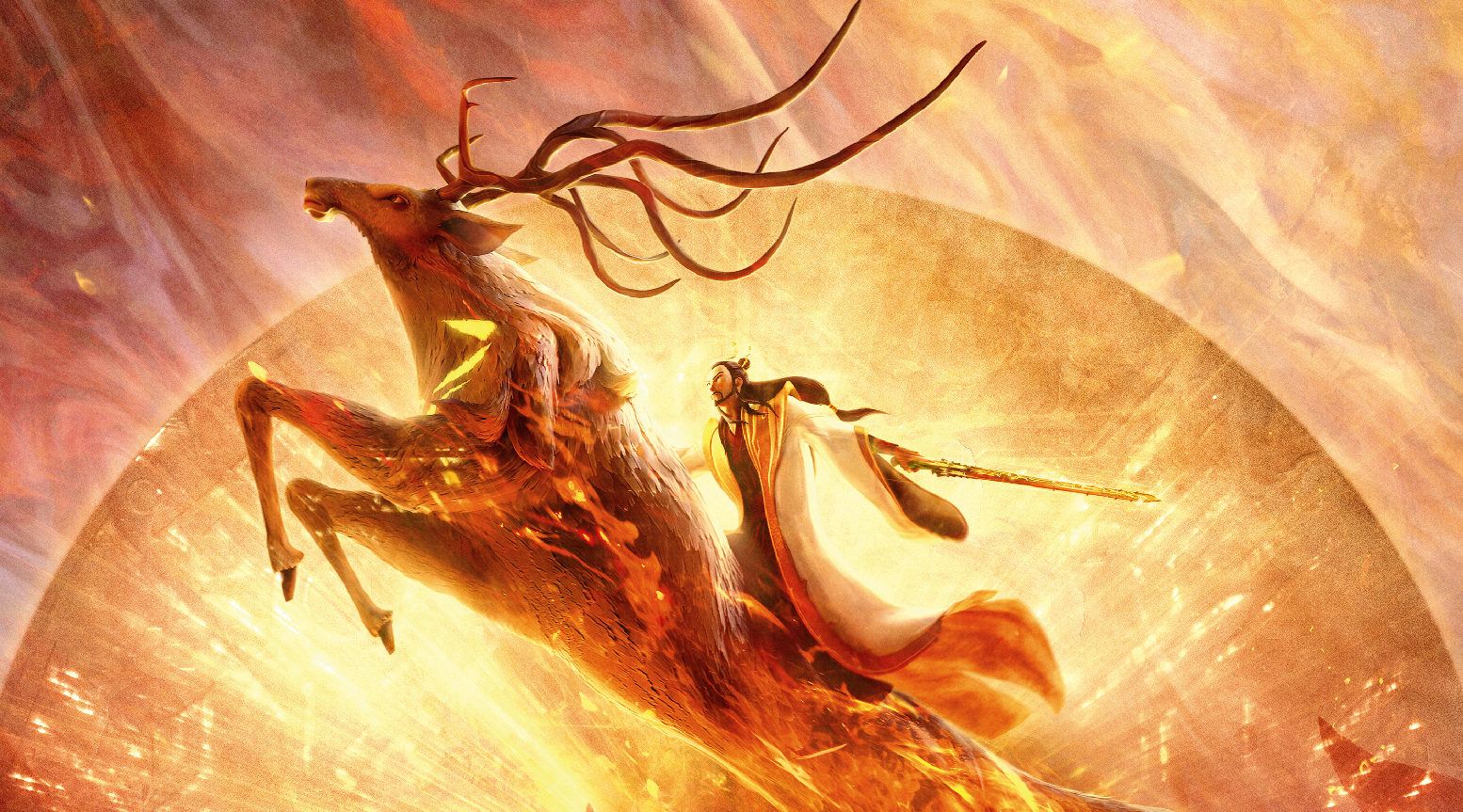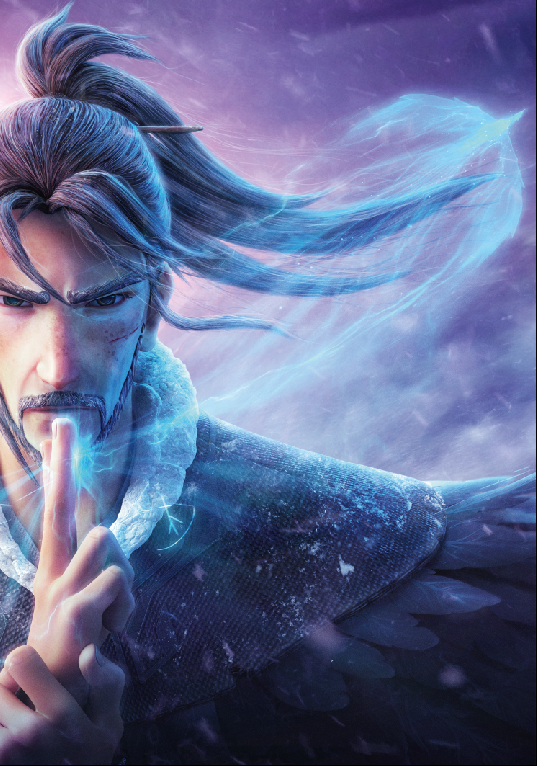Legend of Deification : Reshaping a Sage

With an air of celestial elegance emanating from a flowing white beard and mustache, he wields the authority over the pantheon with a divine whip in his hand.
This is the portrayal of Jiang Ziya, the “God of Gods,” in the Chinese mythological novel The Investiture of the Gods created during the Ming Dynasty (1368-1644). His position in the Chinese mythological system is comparable to Zeus in Greek mythology and Odin in Norse mythology. Like them, he bestows divine titles upon numerous gods, commanding utmost respect.
Tall and lean, he wears tattered attire, his eyes exuding a profound melancholy, hinting at the weight of ages.
Over three centuries later, in the animated film Legend of Deification released in 2020, Jiang Ziya’s image underwent a remarkable transformation, descending from his divine pedestal to become an ordinary middle-aged man, scorned by society and burdened with obsessive-compulsive disorder.
The Chinese animated film presents both the story of Jiang Ziya and a daring departure from the traditional portrayal of the figure.
Overturning
If one word had to perfectly describe Legend of Deification, it would be “overturn.”
Firstly, the narrative is overturned. In the original novel The Investiture of the Gods, Jiang Ziya’s story follows a particular trajectory: At the age of 32, he ascends Kunlun Mountain to become a disciple of the Primeval Lord of Heaven. At 72, he descends the mountain as requested to aid King Wen and King Wu of the Zhou Dynasty (1046-256 B.C.) in their campaign against the tyrannical King Zhou of the Shang Dynasty (1600-1046 B.C.), while also bestowing titles on 365 heavenly deities.
However, the animated film Legend of Deification veers far from the original storyline of The Investiture of the Gods. It embraces imagination, blends modern aesthetics, and envisions a brand-new sequel.
The entire film revolves around a conspiracy. The Primeval Lord of Heaven harbors ambitions to unify the Three Realms and makes a deal with the Nine-tailed Fox, a mythical creature from Chinese mythology and even in broader East Asian mythology. The story unfolds as follows: The Nine-tailed Fox assumes the guise of Su Daji to enchant King Zhou and incite a war across the Three Realms. In return, she is promised a position among the immortals once the dust settles. However, the Primeval Lord of Heaven breaks his word. He annihilates the clan of the Nine-tailed Fox and commands Jiang Ziya to execute her. But within the body of the Fox, Jiang Ziya catches a glimpse of an innocent human girl, Su Daji. This shakes the foundation of his beliefs. Thus begins his arduous quest for truth.
In this film, Jiang Ziya departs from the traditional portrayal ingrained in the minds of Chinese people—a venerable old sage with flowing white hair. Instead, he emerges as a middle-aged man stripped of his godly characteristics. Grappling with the complex choice between divinity and humanity, the character exhibits perplexity and emotions just like ordinary humans.
Contrasting other animations adapted from legend, Legend of Deification defies expectations even in visual representation. The film emanates a sense of resplendence and oddity. “We established two dominant artistic tones in the beginning: Chinese ink paintings and Cthulhu Mythos,” explained director Cheng Teng. The Cthulhu Mythos, originating from the mythological universe crafted by American writer H.P. Lovecraft, is known for evoking indescribable fear, enigmatic atmospheres, and arcane forces. In this animated adaptation of ancient Chinese mythology, the production team merged Eastern and Western elements boldly to weave a tapestry for a Chinese narrative that can evoke global resonance.

Reshaping
“The adaptation and retelling of Chinese literary classics is a process of cultural reproduction that should embrace both inheritance and innovation to inject contemporary spirit into traditions,” stated producer Gao Weihua. She also serves as a professor at the School of Animation and Digital Arts, Communication University of China. Approximately 70 percent of members of the film’s core production team were college teachers, students, and alumni from animation departments. Their academic background has imbued them with a profound understanding of “how to adapt Chinese classics.” They have the ambition to “inherit Eastern aesthetics and reshape the core of modern sensibilities.”
The film directly evokes a sense of Eastern aesthetic allure, with visuals radiating the poetic and ancient essence embedded in Chinese history. It masterfully merges classical cultural elements with contemporary craftsmanship through the lens of Eastern aesthetics. Such efforts are most notable in scenes inspired by the likes of Jiang Ziya’s tomb and Suzhou gardens, as well as appear in minute details such as intricate designs of talismans and artifacts with motifs from Shang Dynasty relics and the haunting skeletal specter inspired by the mythological creature “Teng Snake” from the ancient work The Classic of Mountains and Seas. The result is a breathtakingly beautiful and mysteriously enchanting world that faithfully resurrects the original book.
In harmony with the film’s traditional Eastern aesthetics is the reshaped modern spirit at the core of the hero Jiang Ziya.
In the original ending of the novel The Investiture of the Gods, Jiang coldly and ruthlessly beheads the Nine-tailed Fox as the executor of divine will. However, in the animated film, Jiang Ziya’s conviction wavers when he sees the human girl within the Nine-tailed Fox’s body. Faced with the classic ethical dilemma of “saving one person or saving the world,” he experiences the same hesitation, confusion, and inner turmoil as any ordinary person.
The result is moving. Jiang Ziya ultimately transforms from a “follower” to a “rebel.” His rebellion represents a profound and unwavering introspection on spiritual dimensions and a rupture from his identity after being blinded by the so-called “heavenly will” for so long. This crisis of faith and the dilemma it presents bestow the animation depth and complexity beyond the original work.
Legend of Deification achieved remarkable box office success, earning revenues totaling 1.6 billion yuan (around US$229 million). The figure made it the second-highest-grossing domestic animated film in China so far. It is an impactful work that offers important insight for Chinese animators: Why can’t serious topics be explored with animation? Why can’t animation address profound and thought-provoking themes while also achieving commercial success?
Chinese animation needs more exploration to find more possibilities.